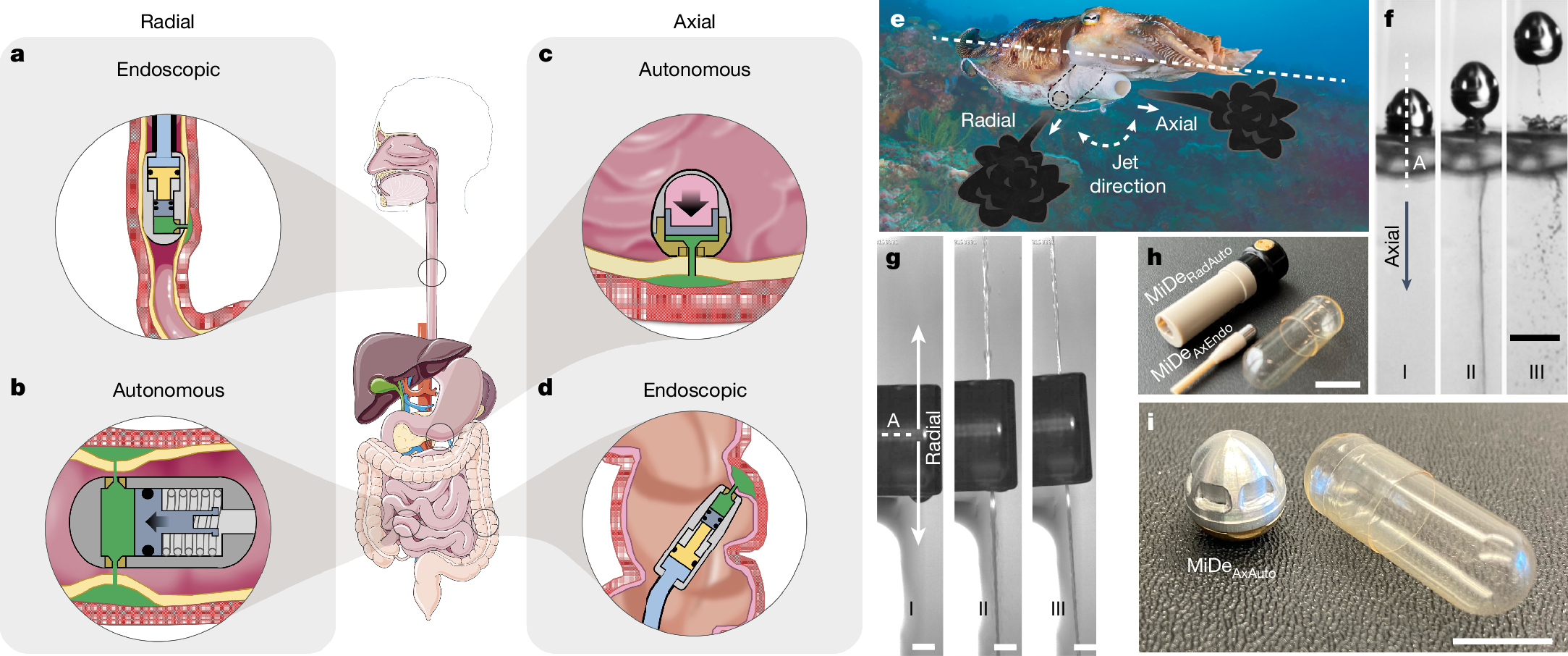2024-11-20 マサチューセッツ工科大学(MIT)
<関連情報>
- https://news.mit.edu/2024/bioinspired-capsule-can-pump-drugs-directly-walls-gi-tract-1120
- https://www.nature.com/articles/s41586-024-08202-5
- https://www.science.org/doi/10.1126/science.aau2277
- https://jpharmsci.org/article/S0022-3549(15)30204-5/fulltext
消化管薬物送達のための頭足類に着想を得た噴射装置 Cephalopod-inspired jetting devices for gastrointestinal drug delivery
G. Arrick,D. Sticker,A. Ghazal,Y. Lu,T. Duncombe,D. Gwynne,B. Mouridsen,J. Wainer,J. P. H. Jepsen,T. S. Last,D. Schultz,K. Hess,E. Medina De Alba,S. Min,M. Poulsen,C. Anker,P. Karandikar,H. D. Pedersen,J. Collins,N. E. Egecioglu,S. Tamang,C. Cleveland,K. Ishida,A. H. Uhrenfeldt,… G. Traverso
Nature Published:20 November 2024
DOI:https://doi.org/10.1038/s41586-024-08202-5

Abstract
Needle-based injections currently enable the administration of a wide range of biomacromolecule therapies across the body, including the gastrointestinal tract1,2,3, through recent developments in ingestible robotic devices4,5,6,7. However, needles generally require training, sharps management and disposal, and pose challenges for autonomous ingestible systems. Here, inspired by the jetting systems of cephalopods, we have developed and evaluated microjet delivery systems that can deliver jets in axial and radial directions into tissue, making them suitable for tubular and globular segments of the gastrointestinal tract. Furthermore, they are implemented in both tethered and ingestible formats, facilitating endoscopic applications or patient self-dosing. Our study identified suitable pressure and nozzle dimensions for different segments of the gastrointestinal tract and applied microjets in a variety of devices that support delivery across the various anatomic segments of the gastrointestinal tract. We characterized the ability of these systems to administer macromolecules, including insulin, a glucagon-like peptide-1 (GLP1) analogue and a small interfering RNA (siRNA) in large animal models, achieving exposure levels similar to those achieved with subcutaneous delivery. This research provides key insights into jetting design parameters for gastrointestinal administration, substantially broadening the possibilities for future endoscopic and ingestible drug delivery devices.
高分子を経口投与するための摂取可能な自己指向性システム An ingestible self-orienting system for oral delivery of macromolecules
Alex Abramson, Ester Caffarel-Salvador, Minsoo Khang, David Dellal, […], and Giovanni Traverso
Science Published:8 Feb 2019
DOI:https://doi.org/10.1126/science.aau2277

Delivering fragile drugs to the gut
Oral delivery is the simplest and least invasive way to deliver many pharmaceuticals, but many drugs and medications, including insulin, cannot survive passage through the stomach or the gastrointestinal tract. Abramson et al. developed an ingestible delivery vehicle that could self-reorient from any starting position so as to attach to the gastric wall. Encapsulation of a spring in a sugar casing allowed for triggered actuation for the delivery of biomolecules. The approach successfully provided active insulin delivery in pigs.
Science, this issue p. 611
Abstract
Biomacromolecules have transformed our capacity to effectively treat diseases; however, their rapid degradation and poor absorption in the gastrointestinal (GI) tract generally limit their administration to parenteral routes. An oral biologic delivery system must aid in both localization and permeation to achieve systemic drug uptake. Inspired by the leopard tortoise’s ability to passively reorient, we developed an ingestible self-orienting millimeter-scale applicator (SOMA) that autonomously positions itself to engage with GI tissue. It then deploys milliposts fabricated from active pharmaceutical ingredients directly through the gastric mucosa while avoiding perforation. We conducted in vivo studies in rats and swine that support the applicator’s safety and, using insulin as a model drug, demonstrated that the SOMA delivers active pharmaceutical ingredient plasma levels comparable to those achieved with subcutaneous millipost administration.
消化管を介した薬物送達のためのマイクロニードル Microneedles for Drug Delivery via the Gastrointestinal Tract
Giovanni Traverso∙ Carl M. Schoellhammer∙ Avi Schroeder∙ … ∙ Daniel G. Anderson ∙ Daniel Blankschtein∙ Robert Langer
Journal of Pharmaceutical Sciences Accepted: September 2, 2014
DOI:https://doi.org/10.1002/jps.24182

ABSTRACT
Both patients and physicians prefer the oral route of drug delivery. The gastrointestinal (GI) tract, though, limits the bioavailability of certain therapeutics because of its protease and bacteria-rich environment as well as general pH variability from pH 1 to 7. These extreme environments make oral delivery particularly challenging for the biologic class of therapeutics. Here, we demonstrate proof-of-concept experiments in swine that microneedle-based delivery has the capacity for improved bioavailability of a biologically active macromolecule. Moreover, we show that microneedle-containing devices can be passed and excreted from the GI tract safely. These findings strongly support the success of implementation of microneedle technology for use in the GI tract. © 2014 Wiley Periodicals, Inc. and the American Pharmacists Association J Pharm Sci 104:362–367, 2015

00507-2/asset/89f5ad73-0424-4de0-85a8-8cca4e8e5393/main.assets/gr1.jpg)
